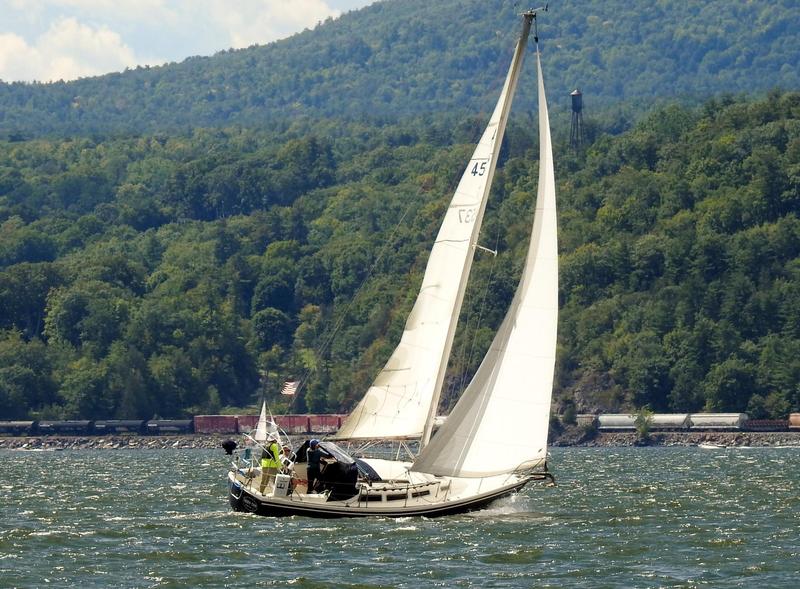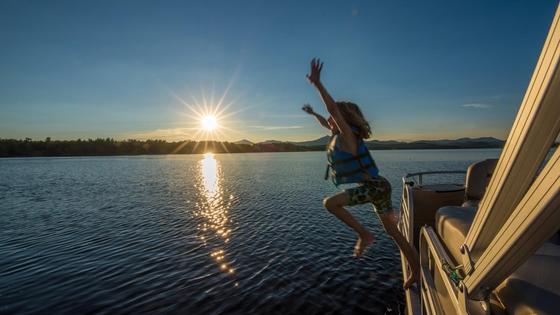New England is known for its stunning natural landscapes and abundant bodies of water. From picturesque coastlines to lush forests, this region is a haven for outdoor enthusiasts. One of the most captivating features of New England's geography is its lakes. In this article, we will explore the biggest lakes in New England and delve into their geological significance, ecological importance, and conservation efforts. Let's dive in!
Understanding the Geography of New England
New England is a region in the northeastern part of the United States, comprising six states: Connecticut, Maine, Massachusetts, New Hampshire, Rhode Island, and Vermont. This region is defined by its diverse topography, which includes mountains, valleys, and of course, lakes. The lakes in New England are a testament to the region's glacial past and the impact of climate over thousands of years.
Exploring the geographical wonders of New England reveals a tapestry woven by ancient glaciers and shaped by the ever-changing climate. The rugged beauty of the region's landscape is a result of a tumultuous history that dates back to the Ice Age, leaving behind a legacy of stunning lakes that dot the countryside.
The Role of Glaciers in Shaping New England's Lakes
During the last Ice Age, massive glaciers covered the land, shaping the landscape we see today. As these glaciers advanced and retreated, they carved valleys and created basins that eventually filled with water, forming many of the lakes we know and love in New England. The deep, clear waters of these glacial lakes attract people from far and wide, offering not only recreational opportunities but also a glimpse into the region's geological history.
Tracing the footsteps of ancient glaciers, one can witness the profound impact of these icy behemoths on the formation of New England's lakes. From the serene beauty of Walden Pond in Massachusetts to the majestic expanse of Lake Champlain in Vermont, each body of water tells a story of resilience and transformation etched into the very fabric of the land.
The Impact of Climate on Lake Formation
The formation and characteristics of lakes in New England are also influenced by climate. The amount of precipitation, temperature fluctuations, and the overall climate patterns of the region play a vital role in the development of these water bodies. From chilly mountain lakes to warmer, more temperate lakes in coastal areas, New England's lakes showcase the diversity of the region's climate.
Beyond their picturesque charm, the lakes of New England serve as a barometer of the region's climate health, reflecting the delicate balance between nature's forces and human impact. As stewards of these natural treasures, it is essential to understand and appreciate the intricate dance between glaciers of the past and the climate of the present that continues to shape the enchanting lakes of New England.
The Five Largest Lakes in New England
Lake Champlain: A Shared Natural Wonder
Lake Champlain, straddling the border between Vermont and New York, is one of the largest and most beloved lakes in New England. With a surface area of over 490 square miles, Lake Champlain offers endless opportunities for boating, fishing, and exploring its numerous islands. The lake's rich history and stunning natural beauty make it a favorite destination for locals and visitors alike. Whether you're sailing its waters, hiking its shores, or simply enjoying a picnic with a view, Lake Champlain never fails to enchant.

Moosehead Lake: Maine's Crown Jewel
Nestled in the heart of Maine, Moosehead Lake reigns as the state's largest lake and an outdoor enthusiast's paradise. Spanning over 120 square miles, Moosehead Lake boasts pristine waters, remote islands, and rugged mountain landscapes. From fishing for landlocked salmon to embarking on thrilling wildlife-watching adventures, Moosehead Lake offers a true escape into nature. Whether you prefer kayaking along its tranquil shores or hiking through the surrounding wilderness, Moosehead Lake promises an unforgettable experience.
Lake Winnipesaukee: The Smile of the Great Spirit
In the beautiful state of New Hampshire, Lake Winnipesaukee captivates visitors with its charm and grandeur. With a surface area of approximately 72 square miles, this lake is New Hampshire's largest and a beloved summer destination. Its crystal-clear waters invite swimming, boating, and water sports, while the scenic landscapes provide a picture-perfect backdrop for relaxation. Whether you're indulging in a lakeside getaway or exploring the charming towns that dot the shoreline, Lake Winnipesaukee has something for everyone.
Squam Lake: The Silver Lake
Squam Lake, situated in central New Hampshire, is renowned for its sheer beauty and tranquil surroundings. Covering around 6,700 acres, Squam Lake's deep, clear waters have been a source of inspiration for artists, writers, and nature enthusiasts for generations. Exploring its many islands, fishing for bass, or embarking on a bird-watching adventure are just a few of the experiences that await visitors to Squam Lake. Whether you're seeking solitude or an active outdoor excursion, Squam Lake never disappoints.
Sebago Lake: The Deep Beauty
Located in southwestern Maine, Sebago Lake is not only one of the largest lakes in New England but also a recreational playground for locals and tourists alike. Covering over 45 square miles, Sebago Lake allures with its sparkling waters and sandy beaches. Boasting excellent fishing opportunities, water sports galore, and breathtaking sunsets, Sebago Lake beckons visitors to create lifelong memories. Whether you're lounging on the beach or cruising the lake on a pontoon boat, Sebago Lake offers a quintessential New England lake experience.
As you explore the five largest lakes in New England, you'll discover a region teeming with natural wonders and recreational opportunities. Each lake has its own unique character and allure, providing visitors with a diverse range of experiences to enjoy.
Imagine yourself on the shores of Lake Champlain, feeling the gentle breeze on your face as you set sail on its expansive waters. The lake's history comes alive as you learn about its role in the American Revolution and the stories of the communities that have thrived along its shores for centuries.
Or picture yourself in the heart of Maine, surrounded by the majestic beauty of Moosehead Lake. As you cast your line into the water, you can't help but be captivated by the tranquility of the surroundings. The call of loons echoes across the lake, reminding you of the untamed wilderness that stretches as far as the eye can see.
Traveling to Lake Winnipesaukee, you'll be greeted by the vibrant energy of summer. The lake comes alive with the laughter of families enjoying water sports and the sound of live music drifting from lakeside venues. Take a stroll through the charming towns that line the shoreline, where you'll find quaint shops, delicious local cuisine, and friendly faces eager to share their love for this beloved destination.
As you venture to Squam Lake, you'll be transported to a place of serenity and inspiration. The stillness of the water reflects the surrounding mountains, creating a breathtaking vista that has inspired countless artists and writers. Explore the hidden coves and secluded beaches, and let the tranquility of this hidden gem wash over you.
Finally, make your way to Sebago Lake, where the beauty of nature unfolds before your eyes. Spend your days basking in the sun on sandy beaches, or embark on a thrilling water skiing adventure. As the sun sets over the lake, casting a warm glow across the water, you'll realize that Sebago Lake is not just a destination, but a place where memories are made.
So whether you're seeking adventure, relaxation, or a little bit of both, the five largest lakes in New England offer a world of possibilities. From the shared wonder of Lake Champlain to the deep beauty of Sebago Lake, these natural treasures are waiting to be explored and cherished.
The Importance of Lakes to New England's Ecosystem
Lakes as Habitats for Diverse Species
New England's lakes are not only recreational havens but also vital habitats for a wide array of species. From fish and waterfowl to amphibians and aquatic plants, these lakes support a rich biodiversity that plays a crucial role in maintaining the region's ecological balance. Protecting and preserving these habitats is essential for the long-term health of the ecosystem and the creatures that depend on them.
Lakes in the Water Cycle
Lakes play an integral role in the water cycle, acting as storage reservoirs for precipitation and feeding rivers and streams that sustain surrounding landscapes. They help regulate the flow of water, ensuring the availability of freshwater for drinking, agriculture, and other human needs. Preserving the quality and quantity of water in New England's lakes is crucial for maintaining a sustainable water supply for both wildlife and communities.
Conservation Efforts for New England's Lakes
Threats to Lake Ecosystems
New England's lakes face various threats, including pollution, invasive species, and climate change impacts. Human activities, such as urban development and improper waste management, can degrade water quality and harm the delicate balance of lake ecosystems. Additionally, the introduction of non-native species can disrupt the native flora and fauna, altering the entire ecosystem. Understanding these threats and taking action to address them is essential for the preservation of New England's lakes.
Role of Local Communities in Lake Conservation
Local communities play a vital role in lake conservation efforts. Through education, outreach, and active participation, individuals can contribute to the preservation and sustainable use of New England's lakes. By practicing responsible boating, reducing pollution, and supporting initiatives that promote ecosystem health, communities can help ensure that future generations can continue to enjoy the beauty and tranquility of these magnificent lakes. Organizations like Getmyboat facilitate connections between individuals and lake-based activities, making it easier than ever to explore and enjoy these natural wonders responsibly.
In conclusion, New England's biggest lakes offer not only breathtaking beauty but also a rich tapestry of ecological wonders. From their glacial origins to their importance in the water cycle, these lakes are an integral part of the region's identity. By valuing and safeguarding these natural treasures, we can ensure that New England's lakes continue to inspire and sustain us for generations to come. So, grab your fishing rod or paddleboard and embark on an adventure to discover the majestic lakes of New England through the lens of preservation and appreciation.
Discover New England's Lakes with Getmyboat
Ready to experience the biggest lakes in New England from a new perspective? Make it a boat day with Getmyboat, the #1 app for boat rentals and charters. Immerse yourself in the beauty of these natural wonders by booking your own boat rental, jet ski, yacht, pontoon boat, or fishing charter. Whether you're seeking a serene solo adventure or an exciting group outing, Getmyboat connects you directly with boat owners and captains for a secure and personalized booking experience. With over 150,000 boats available in top boating destinations, your perfect lake day is just a click away. Make it a boat day and create memories that will last a lifetime on the enchanting lakes of New England.










